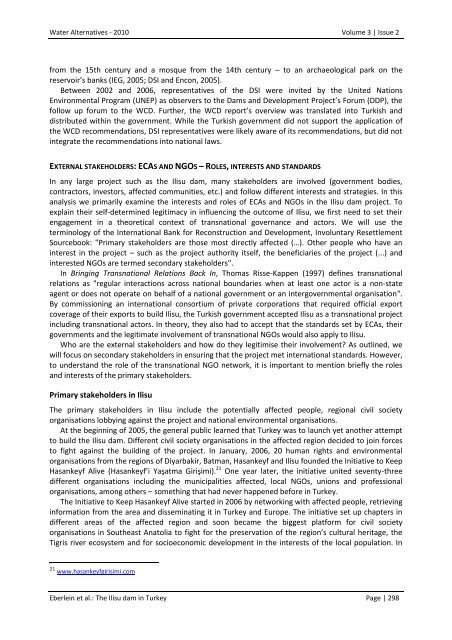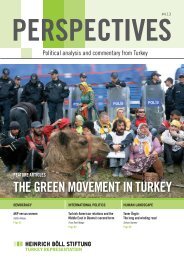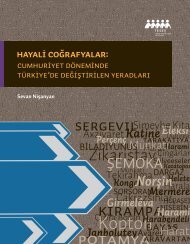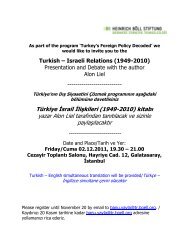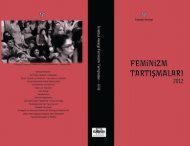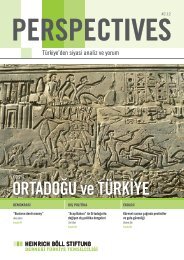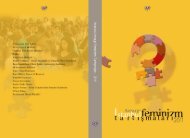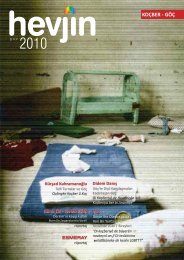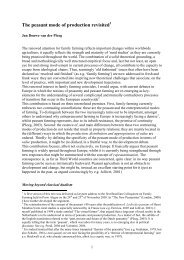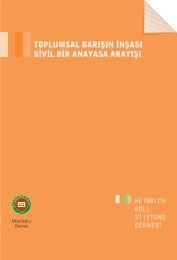The Ilisu Dam in Turkey and the Role of Export Credit Agencies and ...
The Ilisu Dam in Turkey and the Role of Export Credit Agencies and ...
The Ilisu Dam in Turkey and the Role of Export Credit Agencies and ...
Create successful ePaper yourself
Turn your PDF publications into a flip-book with our unique Google optimized e-Paper software.
Water Alternatives - 2010 Volume 3 | Issue 2<br />
from <strong>the</strong> 15th century <strong>and</strong> a mosque from <strong>the</strong> 14th century – to an archaeological park on <strong>the</strong><br />
reservoir’s banks (IEG, 2005; DSI <strong>and</strong> Encon, 2005).<br />
Between 2002 <strong>and</strong> 2006, representatives <strong>of</strong> <strong>the</strong> DSI were <strong>in</strong>vited by <strong>the</strong> United Nations<br />
Environmental Program (UNEP) as observers to <strong>the</strong> <strong>Dam</strong>s <strong>and</strong> Development Project’s Forum (DDP), <strong>the</strong><br />
follow up forum to <strong>the</strong> WCD. Fur<strong>the</strong>r, <strong>the</strong> WCD report’s overview was translated <strong>in</strong>to Turkish <strong>and</strong><br />
distributed with<strong>in</strong> <strong>the</strong> government. While <strong>the</strong> Turkish government did not support <strong>the</strong> application <strong>of</strong><br />
<strong>the</strong> WCD recommendations, DSI representatives were likely aware <strong>of</strong> its recommendations, but did not<br />
<strong>in</strong>tegrate <strong>the</strong> recommendations <strong>in</strong>to national laws.<br />
EXTERNAL STAKEHOLDERS: ECAS AND NGOS – ROLES, INTERESTS AND STANDARDS<br />
In any large project such as <strong>the</strong> <strong>Ilisu</strong> dam, many stakeholders are <strong>in</strong>volved (government bodies,<br />
contractors, <strong>in</strong>vestors, affected communities, etc.) <strong>and</strong> follow different <strong>in</strong>terests <strong>and</strong> strategies. In this<br />
analysis we primarily exam<strong>in</strong>e <strong>the</strong> <strong>in</strong>terests <strong>and</strong> roles <strong>of</strong> ECAs <strong>and</strong> NGOs <strong>in</strong> <strong>the</strong> <strong>Ilisu</strong> dam project. To<br />
expla<strong>in</strong> <strong>the</strong>ir self-determ<strong>in</strong>ed legitimacy <strong>in</strong> <strong>in</strong>fluenc<strong>in</strong>g <strong>the</strong> outcome <strong>of</strong> <strong>Ilisu</strong>, we first need to set <strong>the</strong>ir<br />
engagement <strong>in</strong> a <strong>the</strong>oretical context <strong>of</strong> transnational governance <strong>and</strong> actors. We will use <strong>the</strong><br />
term<strong>in</strong>ology <strong>of</strong> <strong>the</strong> International Bank for Reconstruction <strong>and</strong> Development, Involuntary Resettlement<br />
Sourcebook: "Primary stakeholders are those most directly affected (…). O<strong>the</strong>r people who have an<br />
<strong>in</strong>terest <strong>in</strong> <strong>the</strong> project – such as <strong>the</strong> project authority itself, <strong>the</strong> beneficiaries <strong>of</strong> <strong>the</strong> project (...) <strong>and</strong><br />
<strong>in</strong>terested NGOs are termed secondary stakeholders".<br />
In Br<strong>in</strong>g<strong>in</strong>g Transnational Relations Back In, Thomas Risse-Kappen (1997) def<strong>in</strong>es transnational<br />
relations as "regular <strong>in</strong>teractions across national boundaries when at least one actor is a non-state<br />
agent or does not operate on behalf <strong>of</strong> a national government or an <strong>in</strong>tergovernmental organisation".<br />
By commission<strong>in</strong>g an <strong>in</strong>ternational consortium <strong>of</strong> private corporations that required <strong>of</strong>ficial export<br />
coverage <strong>of</strong> <strong>the</strong>ir exports to build <strong>Ilisu</strong>, <strong>the</strong> Turkish government accepted <strong>Ilisu</strong> as a transnational project<br />
<strong>in</strong>clud<strong>in</strong>g transnational actors. In <strong>the</strong>ory, <strong>the</strong>y also had to accept that <strong>the</strong> st<strong>and</strong>ards set by ECAs, <strong>the</strong>ir<br />
governments <strong>and</strong> <strong>the</strong> legitimate <strong>in</strong>volvement <strong>of</strong> transnational NGOs would also apply to <strong>Ilisu</strong>.<br />
Who are <strong>the</strong> external stakeholders <strong>and</strong> how do <strong>the</strong>y legitimise <strong>the</strong>ir <strong>in</strong>volvement? As outl<strong>in</strong>ed, we<br />
will focus on secondary stakeholders <strong>in</strong> ensur<strong>in</strong>g that <strong>the</strong> project met <strong>in</strong>ternational st<strong>and</strong>ards. However,<br />
to underst<strong>and</strong> <strong>the</strong> role <strong>of</strong> <strong>the</strong> transnational NGO network, it is important to mention briefly <strong>the</strong> roles<br />
<strong>and</strong> <strong>in</strong>terests <strong>of</strong> <strong>the</strong> primary stakeholders.<br />
Primary stakeholders <strong>in</strong> <strong>Ilisu</strong><br />
<strong>The</strong> primary stakeholders <strong>in</strong> <strong>Ilisu</strong> <strong>in</strong>clude <strong>the</strong> potentially affected people, regional civil society<br />
organisations lobby<strong>in</strong>g aga<strong>in</strong>st <strong>the</strong> project <strong>and</strong> national environmental organisations.<br />
At <strong>the</strong> beg<strong>in</strong>n<strong>in</strong>g <strong>of</strong> 2005, <strong>the</strong> general public learned that <strong>Turkey</strong> was to launch yet ano<strong>the</strong>r attempt<br />
to build <strong>the</strong> <strong>Ilisu</strong> dam. Different civil society organisations <strong>in</strong> <strong>the</strong> affected region decided to jo<strong>in</strong> forces<br />
to fight aga<strong>in</strong>st <strong>the</strong> build<strong>in</strong>g <strong>of</strong> <strong>the</strong> project. In January, 2006, 20 human rights <strong>and</strong> environmental<br />
organisations from <strong>the</strong> regions <strong>of</strong> Diyarbakir, Batman, Hasankeyf <strong>and</strong> <strong>Ilisu</strong> founded <strong>the</strong> Initiative to Keep<br />
Hasankeyf Alive (Hasankeyf’i Yaşatma Girişimi). 21 One year later, <strong>the</strong> <strong>in</strong>itiative united seventy-three<br />
different organisations <strong>in</strong>clud<strong>in</strong>g <strong>the</strong> municipalities affected, local NGOs, unions <strong>and</strong> pr<strong>of</strong>essional<br />
organisations, among o<strong>the</strong>rs – someth<strong>in</strong>g that had never happened before <strong>in</strong> <strong>Turkey</strong>.<br />
<strong>The</strong> Initiative to Keep Hasankeyf Alive started <strong>in</strong> 2006 by network<strong>in</strong>g with affected people, retriev<strong>in</strong>g<br />
<strong>in</strong>formation from <strong>the</strong> area <strong>and</strong> dissem<strong>in</strong>at<strong>in</strong>g it <strong>in</strong> <strong>Turkey</strong> <strong>and</strong> Europe. <strong>The</strong> <strong>in</strong>itiative set up chapters <strong>in</strong><br />
different areas <strong>of</strong> <strong>the</strong> affected region <strong>and</strong> soon became <strong>the</strong> biggest platform for civil society<br />
organisations <strong>in</strong> Sou<strong>the</strong>ast Anatolia to fight for <strong>the</strong> preservation <strong>of</strong> <strong>the</strong> region’s cultural heritage, <strong>the</strong><br />
Tigris river ecosystem <strong>and</strong> for socioeconomic development <strong>in</strong> <strong>the</strong> <strong>in</strong>terests <strong>of</strong> <strong>the</strong> local population. In<br />
21 www.hasankeyfgirisimi.com<br />
Eberle<strong>in</strong> et al.: <strong>The</strong> <strong>Ilisu</strong> dam <strong>in</strong> <strong>Turkey</strong> Page | 298


